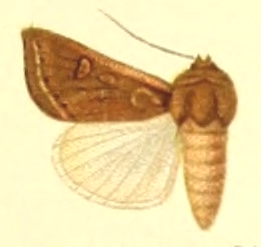Stiria is a genus of moths of the family Noctuidae. The genus was erected by Augustus Radcliffe Grote in 1874.
Timia rugifrons is a species of ulidiid or picture-winged fly in the genus Timia of the family Tephritidae.
Rugomenes is a monotypic Indomalayan genus of potter wasps containing a single species, Rugomenes rugifrons.

Euxoa rugifrons is a moth of the family Noctuidae. It is found in North Africa, including Tunisia, Algeria, Morocco and Libya.
Timia is a genus of flies in the family Ulidiidae, which is difficult to separate from the genus Ulidia.
Plicagonum is a genus of ground beetles in the family Carabidae. There are at least three described species in Plicagonum, found in Indonesia and Papua New Guinea.

Neodiprion is a genus of sawflies in the family Diprionidae.
Chelostomoides is a subgenus of bees in genus Megachile. These bees do not cut leaves, but rather, use resin, mud, or other materials
Megachile rugifrons is a species of bee in the family Megachilidae. It was described by Smith in 1854.
Anapausa is a genus of longhorn beetles of the subfamily Lamiinae, containing the following species:
Tricondyloides is a genus of longhorn beetles of the subfamily Lamiinae, containing the following species:
Anapausa armata is a species of beetle in the family Cerambycidae. It was described by James Thomson in 1864. It is known from Papua New Guinea.
Anapausa longipennis is a species of beetle in the family Cerambycidae. It was described by Stephan von Breuning in 1966. It is known from New Guinea.
Tricondyloides rugifrons is a species of beetle in the family Cerambycidae. It was described by Stephan von Breuning in 1951.

Luperus is a genus of skeletonizing leaf beetle belonging to the family Chrysomelidae, subfamily Galerucinae.
Thoasia is a genus of beetle in the family Carabidae. It was once classified as a monotypic genus with the species Thoasia rugifrons, however recently three new species was found.
Stiria rugifrons, the yellow sunflower moth, is a species of moth in the family Noctuidae. It is found in North America.

Percassa is a genus of short-horned grasshoppers in the family Acrididae. There is one described species in Percassa, P. rugifrons, found in Australia.

Ypsilotera Monastery, also known as Kalligrafon Monastery (Καλλιγράφων), is a former Eastern Orthodox monastery that is part of the Meteora monastery complex in Thessaly, central Greece.

Pantokratoros Monastery or the Monastery of the Pantocrator, also called the Monastery of the Ascension of the Lord, is a former Eastern Orthodox monastery that is part of the Meteora monastery complex in Thessaly, central Greece. It is located on the eastern side of Dupiani Rock. Only ruins remain today. The wall and foundation ruins are located in a crevice in the rock. The ruins of a tower can also be seen today.





